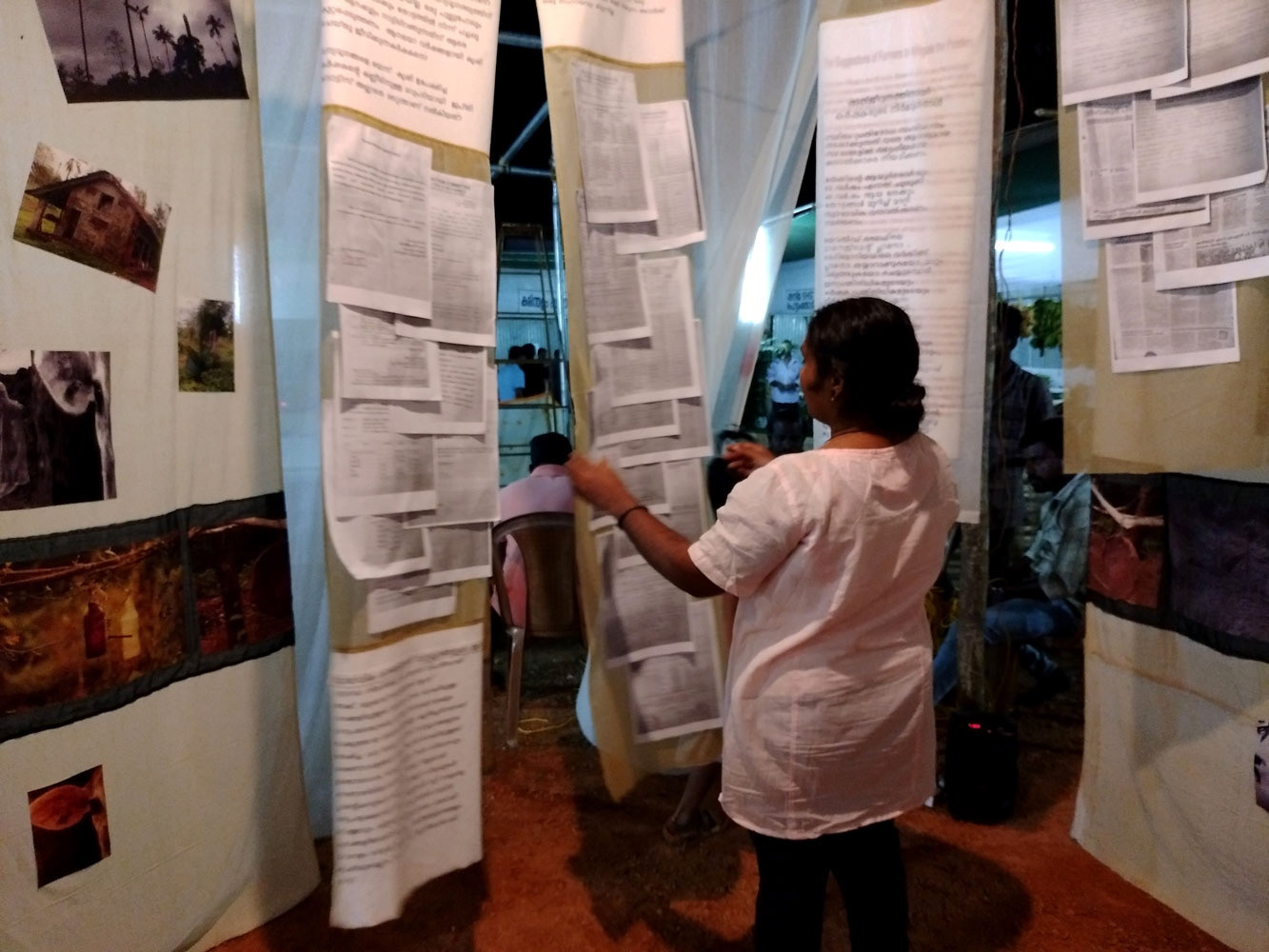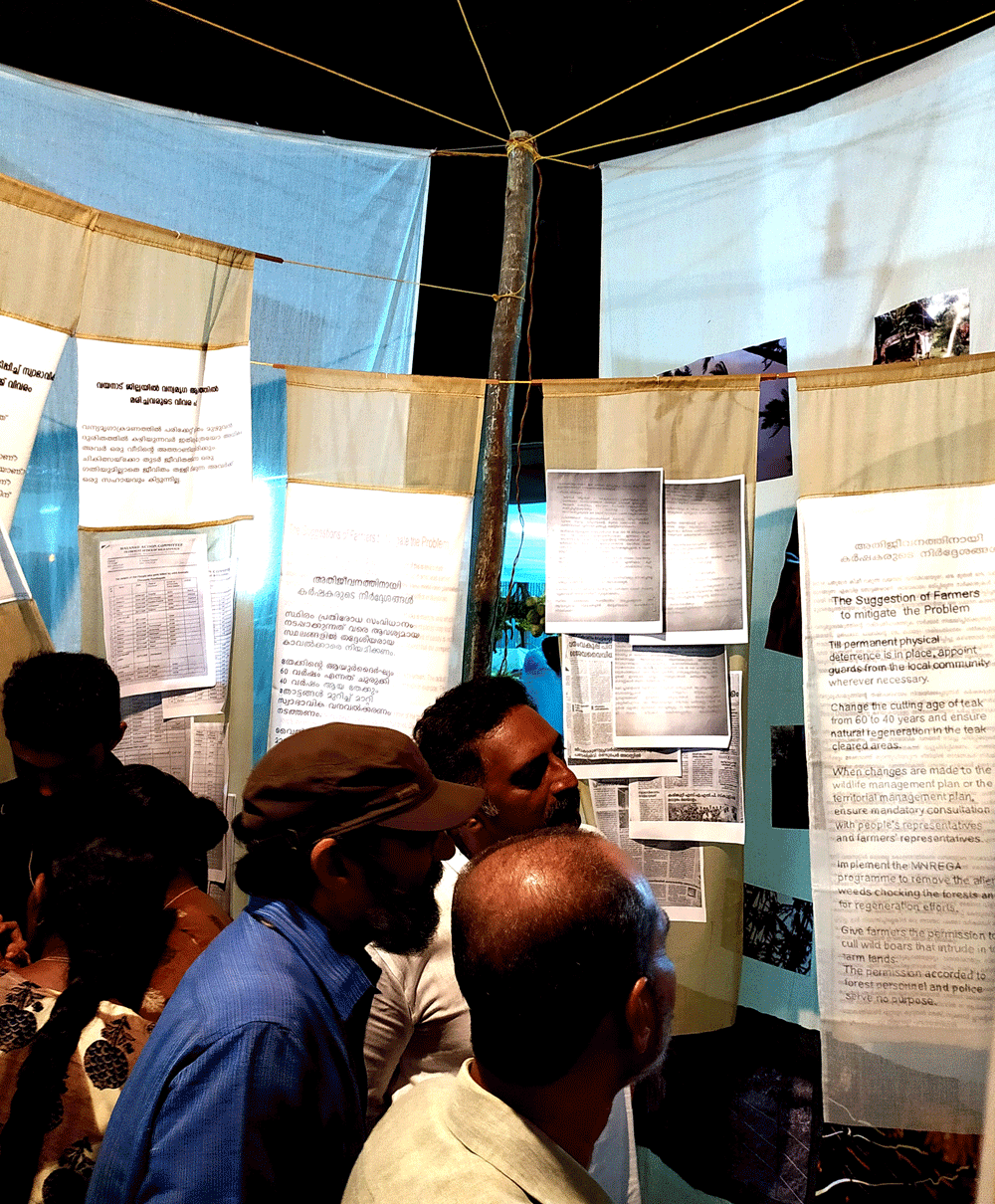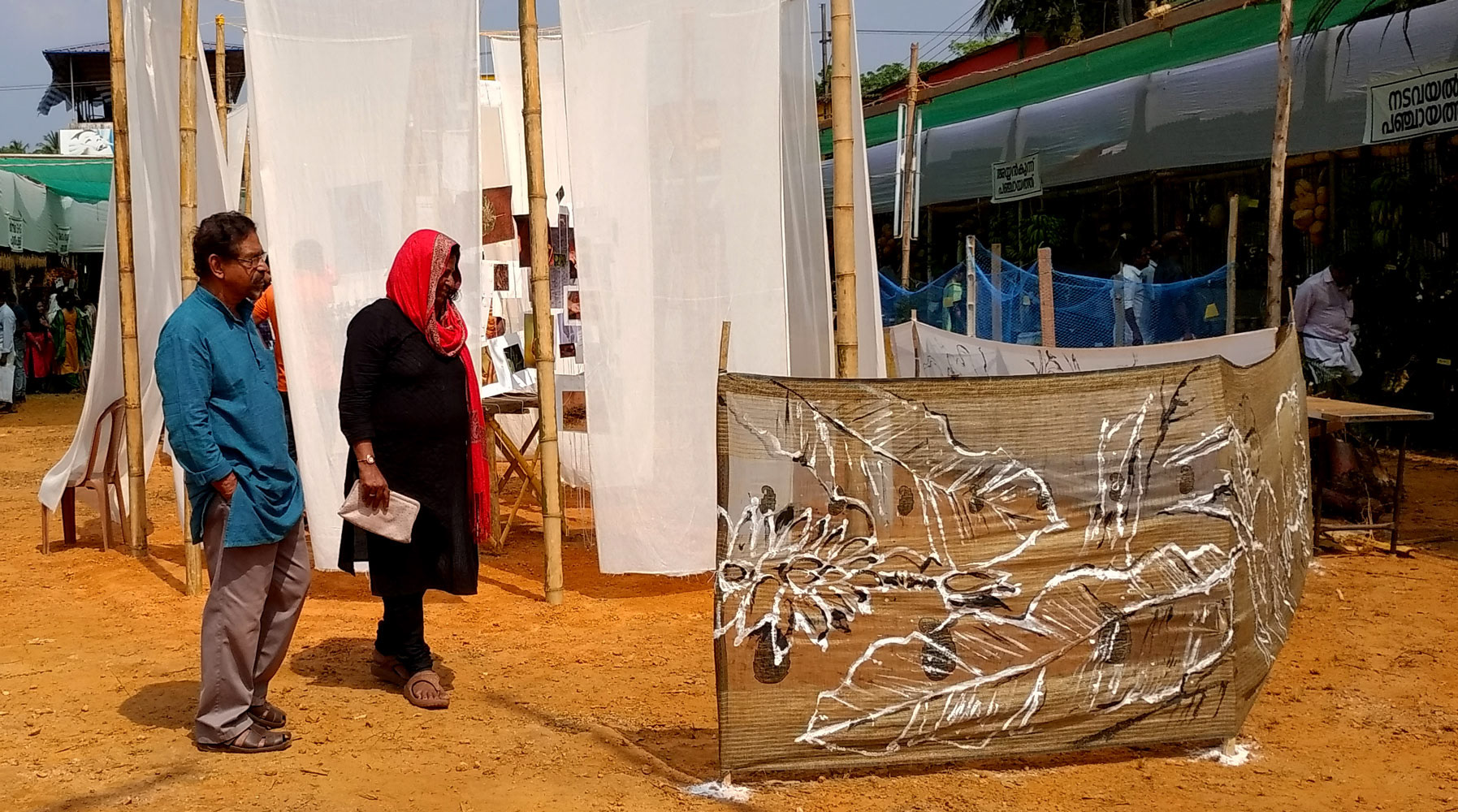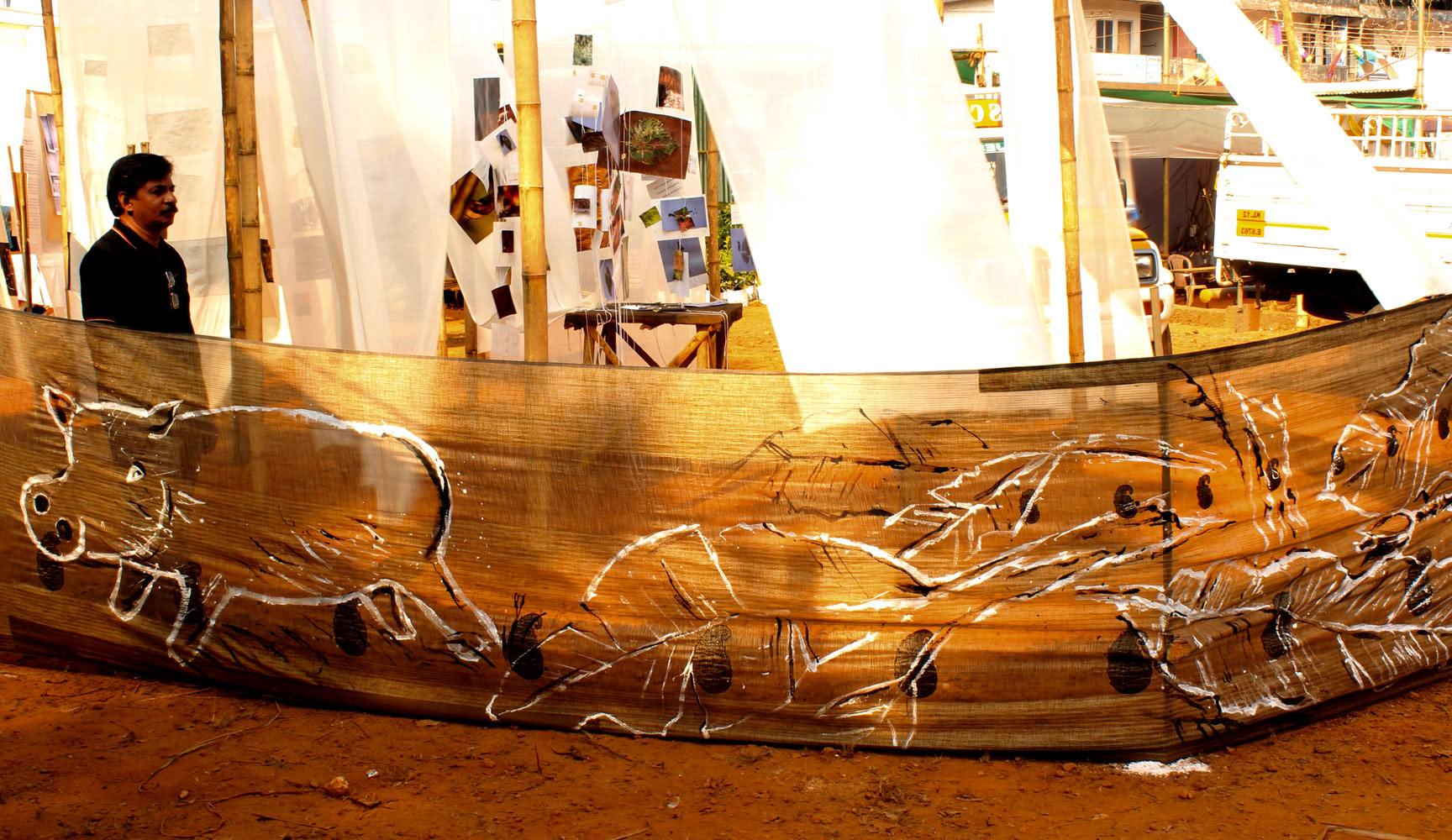The Maze and Fence of Human – Animal conflict presented the concerns through text, images and sound. A sound installation of about fourteen minutes expressed the concerns over a lopsided forest management policy that simultaneously affects human, farm lands, animals and forest, and also presented the solutions that people of the area suggested. These concerns were supported by documents received from state institutions through RTI(they look liked confessional documents on the grave losses farmers continue to face), other data from people, handwritten appeals from the residents, and sound and images. It was also a space for visitors to express their voices in written form on pieces of colour cloths; to be stitched together to make a quilt.
Farmers on maintenance of forest
Listen to the audio
The fourteen minutes audio expresses the concerns over a lopsided forest management policy that simultaneously affects human, farm lands, animals and forest, and also presents the solutions that people of the area suggested. (The sound heard in the background is used by tribes to ward off elephants).
1. The Forest cover of Wayand is about 862 sq kms. Around 25 to 40 percent of this is estimated to be teak and eucalyptus plantations. These mono crop plantations have come up in what was earlier natural forests, lured by the revenue income possible from commercial forestry. These mono crop plantations have accentuated climate change fallout and lies at the root of the human animal conflict in Wayanad.
To add to this, Lantana and Jupiterium have proliferated in the forests. And now the even more dangerous Senna Cassia Spectabilis. We call it the monster weed. It proliferates uncontrollably. It chokes the rest of the forest vegetation and have blocked animal trails. The wild animals are left with no food. The first issue to be addressed to manage human animal conflict is the restoration of the habitat of the wild animals. Natural forests have to be rejuvenated. It should include lot of fruit trees. Check dams may have to be created for the streams and rivulets in the forests, with sluice gates, so that animals get drinking water, fodder grows and the ground water table rises. Besides, there should be steps to prevent the proliferation of vermin creatures like wild boar and monkeys.
Suggestions from Farmers
* Till permanent physical deterrence is in place, appoint guards from the local community wherever necessary.
* Change the cutting age of teak from 60 to 40 years and ensure natural regeneration in the teak cleared areas.
* When changes are made to the wildlife management plan or the territorial management plan, ensure mandatory consultation with people’s representatives and farmers’ representatives.
* Implement the MNREGA programme to remove the alien weeds chocking the forests and for regeneration efforts.
* Give farmers the permission to cull wild boars that intrude in to farm lands to farmers. The permission accorded to forest personnel and police serve no purpose.


On compensation
The compensation fixed by the government for crop loss due to wild animal attacks is meager and is a contempt. Contempt for the farmer. Contempt for the act of farming. Contempt for what he nurtures. The compensation does not meet even a fraction of the actual cost of even the production. For example (as per the calculations done in the year 2019)
The compensation fixed by the government for crop loss due to wild animal attacks is meager and is a contempt. Contempt for the farmer. Contempt for the act of farming. Contempt for what he nurtures. The compensation does not meet even a fraction of the actual cost of even the production. For example (as per the calculations done in the year 2019)
1.The cost of cultivating a hectare of paddy – Rs.75,000/
The expected value of crop per hectare Rs, 1,60,000/-
The compensation paid Rs. 11,000/-
The expected value of crop per hectare Rs, 1,60,000/-
The compensation paid Rs. 11,000/-
2.With all the expenses and cares a coconut tree takes five years to start yielding tangibly.
Tending it for 10-20 years takes much cost, effort and care
A coconut tree could yield for him and his children and grandchildren fruit for about 80 years When a yielding coconut tree destroyed by wild animals earns a compensation of Rs 770.
(less than a day’s wage to an unskilled labourer in the area!)
Tending it for 10-20 years takes much cost, effort and care
A coconut tree could yield for him and his children and grandchildren fruit for about 80 years When a yielding coconut tree destroyed by wild animals earns a compensation of Rs 770.
(less than a day’s wage to an unskilled labourer in the area!)
Even if you reckon the yield for 25 years you should get Rs 25000.
So it is with all crops, seasonal or perennial. They say that the compensation for crop loss should be decided and finalized in consultation with farmers. That has not happened to date.
The farmers ask how to explain this if it is not a contempt. Contempt for the farmer. Contempt for the act of farming. Contempt for what he nurtures.
How to speak of this Pain
When we visited homes and farms, to understand the issues first hand, were surprised that even when all what they grow are destroyed or eaten way by animals, depriving even their basic livelihood, none of them spoke ill of animals. They all said in one voice that they can not blame the animals, they are coming because they are hungry. The farmers voices are only concerning the lopsided forest management policy that simultaneously affects human, farm lands, animals and forest.
T.C. Jose of Wayanad Action Committee to prevent attack of wild animals says that, the people of Wayanad respect forests and wild life and are convinced it must be protected. If the forests are destroyed they see that water sources will be depleted, bio diversity will suffer, climate change will be accentuated. They know all this from experience. The highest number of people killed in wild life attacks in India is in Wayanad. The most severely affected is the Tirunelly Panchayat. In the last three decades 86 people were killed by wild animals there. Tirunelly Panchayat is the hottest area of Wayanad. And it has the largest area cover of teak and eucalyptus plantations! Here a lopsided forest management policy that simultaneously affects human, farm lands, animals and forest.


A 90-foot-long fence made of old sarees, the same way farmers spread cloth around their land to protect their crops from wild boar. A panoramic view of a landscape depicting the relation between humans, farm land, wildlife and forest was drawn on the sarees. And on the inner side of the same sarees, the visitors wrote their responses to human-wildlife issues to form a quilt of responses.
When asked visitors to write their suggestions, many said: “NO USE of making suggestions”. They all wanted the officials to provide a space to sit and discuss the issues respectfully- understanding the animals, forest and the farmers without prejudices.
The pride and prejudice
Just as the farms were subjected to all the elements and forces of nature, the installation too stayed vulnerable. In the night they were soaked by the mist, during the day they shrivelled in the hot sun, absorbed the dust and flapped about in the wind. But for the visitors who were concerned with the subject, it spoke clearly. For some, it was shockingly revealing and gave them information for further dialogue with the authorities. For some it brought them face to face with, and helped clear, their own prejudices. For many it was the voice of their agony, while for some among them it continued to be a point of anger.
Mechanical and abstract knowledge and beauty are driving and defining our sensibilities today. Well shaped and glowing fruits and vegetables found in markets are only minor signs of this divorce from life contexts. There we find no odds and ends, refuse and muck, compromise and wait. There are only right and rights. But the reality of farmers holds everything. The notion of taste and beauty, vision of life, and culture evolved from their reality is different. Where withered, faded, torn, cut, burned, pricked by crow and squirrel, odds and ends, refuse all are accepted and held together. It does not have well defined borderlines.